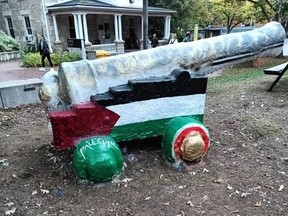World
Controversial Cannon Painting Sparks Outrage at Guelph University

On October 7, 2023, an incident at the University of Guelph involving the painting of a historic cannon ignited significant controversy among students and alumni. Traditionally, this act is a show of school spirit, often linked to sporting events. However, on this particular occasion, the cannon, known as Old Jeremiah, was painted in colors associated with the Palestinian flag, which many interpreted as a political statement amid the ongoing Israel-Gaza conflict.
Retired Canadian Army officer Mark Bossi expressed his outrage over the incident. He noted the date marked the second anniversary of the killings of 1,200 individuals along the Israel-Gaza border, referring to it as a “loud blast” that transformed a lighthearted tradition into a matter of insensitivity. “I am furious that foreign hatred has been imported into Canada,” Bossi stated, emphasizing that such actions contradict the values he believes Canada represents.
The university’s response was swift. According to spokesperson Danny Williamson, the Campus Safety Office was alerted early on October 7 that the cannon had been altered in a manner that potentially violated community guidelines. Upon review, the university decided to repaint the cannon gold, a move intended to align with its guidelines that prohibit messages deemed harmful.
Community Reactions and Implications
The decision to repaint the cannon was met with mixed reactions. While some members of the community support the university’s stance on maintaining a neutral campus environment, others argue that this incident highlights a broader issue of political expression in educational spaces. The act of painting the cannon has typically been viewed as a celebration of school spirit, and the shift to a politically charged message raised questions about the boundaries of free expression on campus.
The university has a longstanding tradition where students paint Old Jeremiah, often in vibrant colors celebrating various events or milestones. This incident, however, appears to have crossed a line for many, drawing comparisons to previous controversial events, such as the playing of “O Canada” in Arabic at a high school in North York, which was widely regarded as unintentional.
As the university navigates this complex situation, the cannon has since been repainted several times with more conventional themes, restoring its role as a symbol of school pride rather than political discourse. This back-and-forth has underscored the challenges institutions face in balancing free expression with community values.
In the wake of the incident, discussions about the role of political expression in educational environments are likely to continue. The university’s actions may set a precedent for handling similar situations in the future, as institutions grapple with how to foster an inclusive space while respecting the diverse views of their student bodies.
The incident at the University of Guelph serves as a potent reminder of the intersections between education, politics, and community values, sparking a dialogue that extends beyond the campus itself.
-

 Politics4 weeks ago
Politics4 weeks agoSecwepemc First Nation Seeks Aboriginal Title Over Kamloops Area
-

 World5 months ago
World5 months agoScientists Unearth Ancient Antarctic Ice to Unlock Climate Secrets
-

 Entertainment5 months ago
Entertainment5 months agoTrump and McCormick to Announce $70 Billion Energy Investments
-

 Science5 months ago
Science5 months agoFour Astronauts Return to Earth After International Space Station Mission
-

 Lifestyle5 months ago
Lifestyle5 months agoTransLink Launches Food Truck Program to Boost Revenue in Vancouver
-

 Technology3 months ago
Technology3 months agoApple Notes Enhances Functionality with Markdown Support in macOS 26
-

 Lifestyle3 months ago
Lifestyle3 months agoManitoba’s Burger Champion Shines Again Amid Dining Innovations
-

 Top Stories2 months ago
Top Stories2 months agoUrgent Update: Fatal Crash on Highway 99 Claims Life of Pitt Meadows Man
-

 Politics4 months ago
Politics4 months agoUkrainian Tennis Star Elina Svitolina Faces Death Threats Online
-

 Sports5 months ago
Sports5 months agoSearch Underway for Missing Hunter Amid Hokkaido Bear Emergency
-

 Politics5 months ago
Politics5 months agoCarney Engages First Nations Leaders at Development Law Summit
-

 Technology5 months ago
Technology5 months agoFrosthaven Launches Early Access on July 31, 2025




















